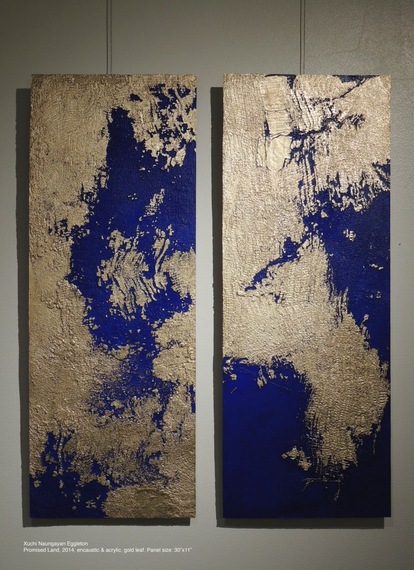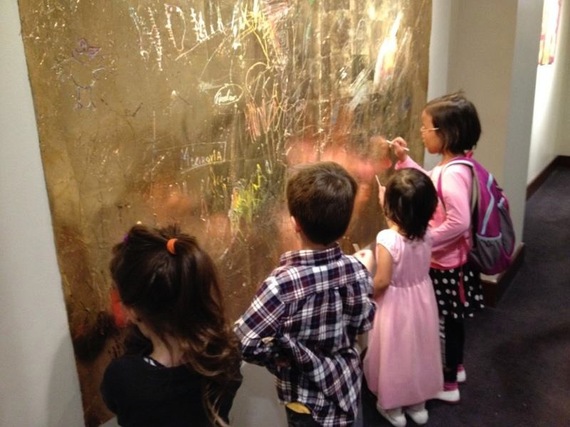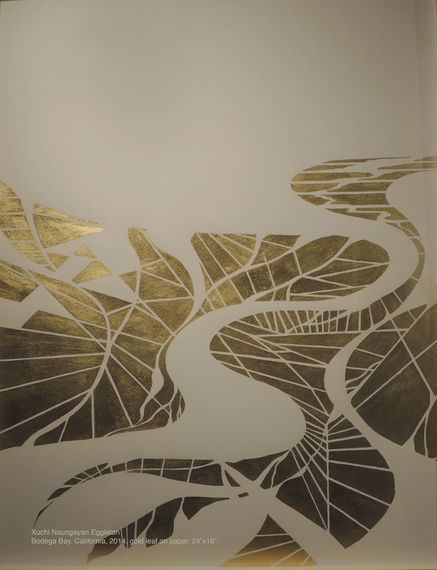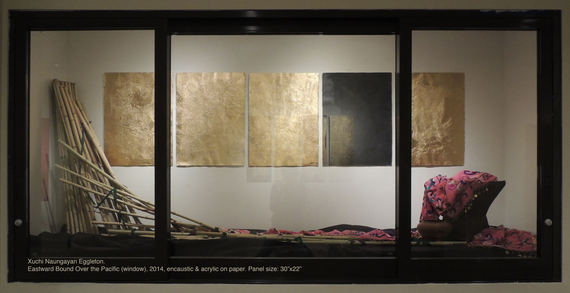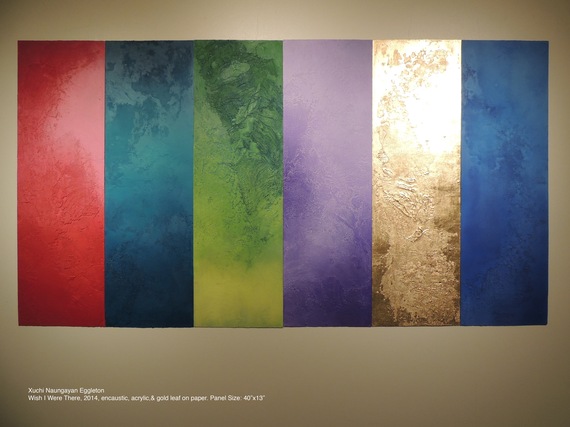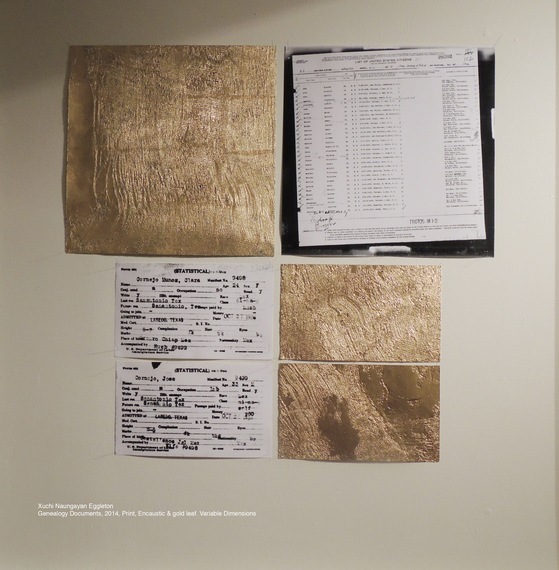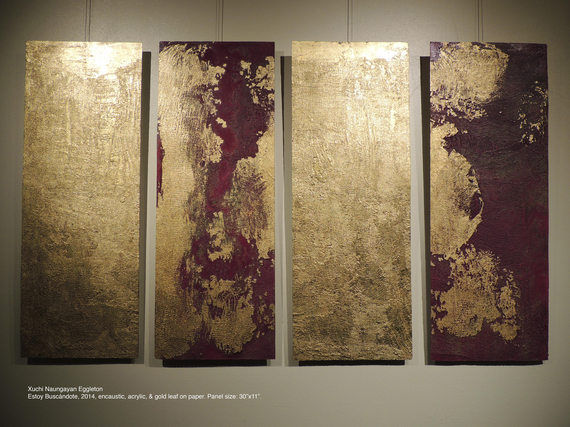"We map the world as it is -- not as people would like it to be," announced the National Geographic, shortly after Russian soldiers stormed Ukrainian military bases in Crimea, and the National Geographic was reportedly preparing to change the color of the Crimea on its maps of Eastern Europe.
The latest work of artist Xuchi Naungayan Eggleton may provoke heartburn among cartographers of that august institution. Wish I Were There: Imagined Geographies, now on display at the Oakland Asian Cultural Center, maps the backbreaking journeys of Naungayan Eggleton's grandparents to the United States -- poor fishing families from Ilocos Sur in the Philippines, and the Mexican province of Chiapas -- filtered through hazy memory, mercurial associations, and the artist's predilection for working with tactile materials and sculptural forms. While the subtext of the exhibit may be personal and historical, and the titles evocative of place, much of the individual work itself could as easily chart the surface of the moon, or the Los Alamos desert birthplace of the atomic bomb, or bacterial cultures growing in a petri dish -- depending on what we bring to it.
For this non-traditional, mixed use space -- delightfully situated at the heart of a busy Oakland mall and catering to an ethnically diverse, multi-generational demographic -- Naungayan Eggleton has flattened her work and moved away from her customary monochromatic palette, producing vertical panels whose saturated colors and sheens leap off the walls, the textures of the multi-layered encaustic painting dripping with gold and silver leaf and tempting the fingers. In fact, at the exhibit's opening, children in attendance were invited to scratch through the surface gold leaf of a painting with wooden sticks -- in imitation of the ancient Philippine art of Kut Kut ("scratching," in the Visayan language) -- to reveal its prismatic substrata.
The practice of layering molten wax colors harks back to Greco-Roman times, and Naungayan Eggleton makes liberal use of fanciful gilded ornamentation not unlike that which one finds on a Venetian carnival mask or in ancient Chinese and Japanese scrolls. Along with beaded fabric, a potted cactus, and bamboo artifacts in two window installations, this ornamentation contrasts with the simplicity of her panels' sharp, frameless edges.
With the military flair of a striped flag, Wish I Were There subtly pokes fun at the propensity to oversimplify the world by coloring in maps ("red states" vs. "blue states") and by drawing artificial borders, thus amplifying divisions between communities. The inflammatory rhetoric around migration at the Texas-Mexico border, and the hostile maneuvers by the Chinese navy in the oil-rich South China Sea territories claimed by the Philippines, Vietnam, Taiwan, Malaysia and Brunei spring to mind.
In two-dimensional maps, the leftmost edge is understood to adjoin the rightmost edge: the idea of the sun rising in the east (birth) and setting in the west (death) linked in a manner that poets often use to comfort non-poets. Hence John Donne's invocation: "As west and east / In all flat maps (and I am one) are one, / So death doth touch the resurrection." As the world is mapped and understood, poets and artists may argue that east and west, life and death converge: a reassurance reflected in the timeless, Zen-like quality of Naungayan Eggleton's work, that radiates from the materials themselves, and from their layering and juxtapositions, quite apart from any concrete associations the work may elicit.
It is impossible, though, to ignore in this exhibit a preoccupation with wealth and the material world. Casually affixed to a wall, original immigration papers documenting the artist's grandparents' arrival in the U.S. are paired with shimmering sheets of roughly textured gold leaf. The lure of the American Dream, the Gold Rush, the swinging door of America's immigration policy are evoked in Genealogy Documents as well as in Estoy Buscándote (I'm Looking For You) and Promised Land. In the latter, the deep, brilliant blue conjures up not only the sea, but also the wealth and power associated with the color in ancient times, when blue pigments were hard to come by and considered precious -- in particular ultramarine, the French bleu outremer ("other side of the sea"), which had to be painstakingly ground from lapis lazuli mined in Afghanistan.
Promised Land and Estoy Buscándote further call to mind the aerial photographs of the civil war-torn Democratic Republic of Congo, taken by Richard Mosse with infrared film (originally designed by the U.S. military to find soldiers in camouflage). The technique renders the hilly green topography in alarming shades of pink - a metaphor for the scars of war, which are often not readily visible. Mosse's work is currently on view at the Museum of Contemporary Photography in Chicago, in a fascinating exhibit dubbed Phantoms in the Dirt.
A painting is not a picture of an experience; it is an experience. - Mark Rothko
In her voyage through her grandparents' past, Naungayan Eggleton may have tramped the California farms where they worked long hours picking crops. She may have climbed the spectacular Mayan ruins of Chiapas and confronted the ancient frescoes at Bonampak that depict prisoners being prepared for ritual human sacrifices. She may have driven a horse-drawn calesa along the cobblestoned streets of Vigan in Ilocos Sur, a European colonial trading town that remarkably fused Asian building design and construction with Spanish architecture and planning. We're not sure exactly where she went and what she saw, but the dust and noise, the colors and patinas, shards and scintillas that she amassed along the way are captured in the experience she leaves with us.
While the mapmakers of the National Geographic "strive to be apolitical," Naungayan Eggleton freely merges the personal and the political in her imaginary landscapes, recognizing that the very act of mapping is political.
Calling attention to the materials of her art, to their weighty histories, she lures us away from our Google Maps (those fleeting creations that talk to us so that we don't even have to read them) to a fantasy world of seductive silhouettes, textures and juxtapositions.
Wish I Were There: Imagined Geographies continues through October 11, 2014 at the Oakland American Cultural Center, Ninth Street, Suite 290, Oakland, CA - in conjunction with Asian Contemporary Art Week in San Francisco sponsored by the Asian Contemporary Art Consortium (ACAC).

